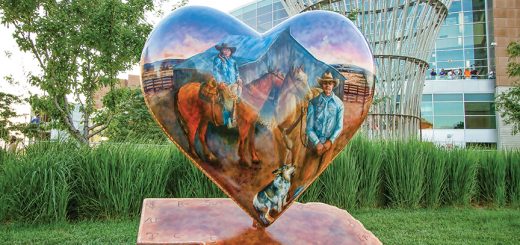A World-Class Art Museum Turns Fifty
By Jorge Daniel Veneciano
Director of the Sheldon Museum of Art
Nebraska landscapes and skyscapes have inspired artists for two centuries in addition to encouraging pioneers and farmers, ranchers and rail men. The earth and the sky offered reasons to settle in this land. And it was the daughters of settlers, as it was in every other quarter of the country, who would transform the magic of place and productivity into the power of cultural and spiritual uplift. They founded our great institutions of art.
Such is the case in Lincoln, where women of vision, working at the University of Nebraska and in the community, took leadership roles in establishing the city as a cultural center beginning in 1888, the year they mounted its first art exhibition. They also helped form a group now known as the Sheldon Art Association (the museum’s dedicated support group), which celebrates its 125th anniversary in 2013. Two notable women of the association were Mary Frances Sheldon and her sister-in-law Olga Sheldon, married to Mary’s brother, Adam Bromley Sheldon. In the 1950s they contributed the vision and funds necessary to build the museum and endow its collections.
Today the finest works of architecture in Lincoln are the Nebraska State Capitol and the Sheldon Museum of Art—two must-see buildings in the city. One is ornate and stylized, a monumental symbol of grandness for the state. The other is an understated testament to elegance and refinement. One is about authority and importance, the other about art, education and beauty.
And it’s Sheldon’s beauty that we celebrate this year, its fifth decade of existence. Sheldon’s building was designed by Philip Johnson, the most influential American architect of the twentieth century. Beginning in 1932, he headed the first architecture department created for a museum—the Museum of Modern Art, New York—and championed modern architecture in the United States. In 1949 Johnson became famous for building the Glass House in New Canaan, Connecticut, a structure whose walls were made entirely of glass. While the architect used it as his own personal retreat, it also stands as one of the great symbols of modern architecture.
For his reputation and interest in museums, Johnson was selected from a pool of internationally renowned architects to design Sheldon. In the 1950s, the University of Nebraska and Sheldon family members who funded the project sought out the best architect available to build a world-class museum in Lincoln.
They succeeded. And we now celebrate the fruits oftheir success.
The high quality of Sheldon’s building has inspired the museum to set an equally high standard for its programs—that is, for what it collects, exhibits, and does to engage and educate the public. These are the community’s successes the collectors who’ve donated works of art or funds for acquisitions, the volunteers who run the Sheldon Art Association and staff the docent corps of museum educators, and the administrators at the University of Nebraska who support and safeguard the museum in indispensible ways.
So what makes the building remarkable? It is an unusual mix of styles: minimal and geometric, yet neoclassical something like a Greek temple with a cool 1960s flare. It’s minimal in that it has flat surfaces and little ornament. It’s more about line and grace and rhythm. Its beauty resides in the materials used and how they come together.
The walls are clad in a form of marble called travertine— a special white variety quarried in Italy, not the polished marble you find in banks or fancy corporate buildings. Tall sheets of glass create central walls and doors—not windows—and are framed in bronze mullions.
Gold-leaf disks hover in a high ceiling, shining down at us like heavenly eyes. Exquisite red teakwood lines the doorways between galleries. These are some of the finest building materials an architect can employ.
Johnson made the best of them all.
When Sheldon was completed in 1963, it was the single most expensive building per square foot ever constructed in the United States. Though this is a remarkable fact, it’s also a testament to achievement, a declaration in standards of quality and ambition, and of resolve to succeed in both.
The Sheldon building is itself a work of art and is said to be the largest work in the museum’s collection.
Special features to look for include the exterior corners of the building: they magically invert from concave to
convex in shape as they move from plinth to cornice; no other building’s corners do this. Walk around and through the museum. Johnson designed his structures to be experienced as you amble through them. I invite you to visit Sheldon and experience one of the nation’s most beautiful museums.














Recent Comments